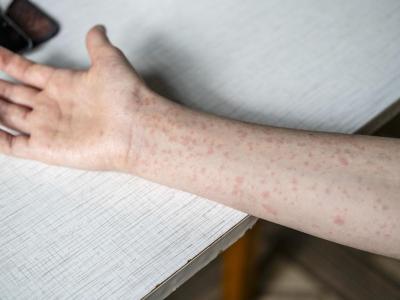Oct 14, 2010
Poll: Only 37% of adults plan to get flu vaccine
A poll of 1,500 adults found that only 37% plan to get this year's influenza vaccine, which provides protection against pandemic H1N1, seasonal H3N2, and influenza B strains. In the poll, by Consumer Reports National Research Center, 30% said they would definitely not get vaccinated, while 31% were undecided. Of parents with children from 6 months to 17 years old, 50% said they would have their kids immunized, whereas 58% of parents in this year's poll had their children immunized last year. In 2008 the parental figure was 41%. Among the undecided, 57% said government guidelines might influence whether they get a vaccine, but 73% said advice from their healthcare provider would have the greatest influence. The poll also showed that last year's media messages helped persuade 35% of people to receive the seasonal flu shot, compared with 16% in 2008. Of the 30% who will not get vaccinated this year, 45% said last year's pandemic was
overblown, 44% said they were concerned about vaccine side effects, 41% were worried about vaccine safety, and 38% said that medicine and other remedies can treat the flu. Consumer Reports, according to a press release today, concluded, "There is no reason to fear this year's vaccine."
Oct 14 Consumer Reports news release
Study shows possible airborne flu spread in hospital
Researchers investigating a seasonal influenza outbreak that occurred in a general medical ward with an open-bay layout found that aerosol transmission may have occurred. They collected real-time epidemiologic and clinical data, conducted spatiotemporal analysis and airflow measurements, and used computational fluid dynamics modeling after nine patients became infected with an identical H3N2 flu strain. In relation to the index patient, the attack rate was 20% in the same bay and 22% in the adjacent bay, compared with 0% in a distant bay. The researchers determined that infection risk was highest on a day when the index patient received noninvasive ventilation. It was later found that air had blown from the index patient's bay toward the adjacent bay. The flow was inadvertently created by an air jet from an air purifier next to the index patient's bed. Modeling revealed that the dispersal pattern of aerosols originating from the
index patient coincided with the bed locations of secondarily infected patients. The authors conclude, "Our findings suggest a possible role of aerosol transmission of influenza in an acute ward setting."
Oct 13 Clin Infect Dis abstract
Members of large households took more steps against H1N1 flu
A survey of 1,290 US adults showed that, during last year's H1N1 flu pandemic, members of larger households were more willing to take pharmaceutical steps and make behavior changes. They also found that, paradoxically, perceived risk increased during the first month of the pandemic, whereas interest in pharmaceutical interventions and involvement in some precautionary activities decreased. Respondents took the online survey from Apr 28 to May 27, 2009. Results also indicated that those living in states with a higher percentage of H1N1 cases perceived a higher H1N1 risk, but this did not translate into a greater likelihood of taking pharmaceutical or behavioral action. Also, women had a higher level than men of perceived risk of infection, willingness to take medications, and involvement in information-seeking activities. The authors conclude, "These patterns will likely influence the effectiveness of disease control
measures."
Oct 14 BMC Infect Dis abstract
NIH grant to help Danish company explore Ebola, Marburg vaccine
Danish pharmaceutical company Bavarian Nordic announced yesterday that it has received a research grant from the US National Institutes of Health (NIH) to support early research on filoviruses such as Ebola and Marburg. In a press release the company said it is exploring whether its core vaccine technology, modified vaccinia Ankara (MVA)-BN, can encode genes for both the Marburg and Ebola strains. The NIH grant, the amount of which was not specified, will enable the company to conduct an efficacy study in nonhuman primates. Initial results are expected next year and will help the firm decide the future of the project. Ebola and Marburg are among the filoviruses that the US government lists as category A bioterrorism agents. In other developments, Bavarian Nordic announced on Oct 12 that the US Biomedical Advanced Research and Development Authority (BARDA) has exercised its next option with the company to develop a
freeze-dried version of its Imvamune smallpox vaccine. The company said the option was triggered by its achievement of certain development milestones and is worth $14 million. It is part of a 5-year, $40 million contract awarded in 2009 to develop a freeze-dried version of Imvamune alongside the liquid-frozen version of the smallpox vaccine, developed as a safer alternative for people with weakened immune systems. This past summer the company delivered the first 1 million doses of Imvamune to the US Strategic National Stockpile.
Oct 13 Bavarian Nordic press release
Oct 12 Bavarian Nordic press release
Two thermal scanners shown effective at detecting fever
Researchers found two of three thermal scanners tested to be reasonably accurate for detecting fever. They tested three scanners: FLIR ThermoVision A20M (FLIR Systems Inc., Boston), OptoTherm Thermoscreen (OptoTherm Thermal Imaging Systems and Infrared Cameras Inc., Sewickley, Pa.), and Wahl Fever Alert Imager HSI2000S (Wahl Instruments Inc., Asheville, N.C.). Of 2,873 patients enrolled in the study, 476 (16.6%) reported a fever, and 64 (2.2%) had a confirmed fever of more than 100°F. The researchers found that sensitivity for the three scanners was not significantly different from self-reporting, but specificity and positive predictive value (PPV) for all three were significantly higher. In addition, at their optimal threshold temperatures, the sensitivity of the three scanners for detecting fever was not significantly different from each other, but the specificity and PPV of OptoTherm and FLIR were significantly higher than
those of Wahl.
Oct 13 Emerg Infect Dis study


















